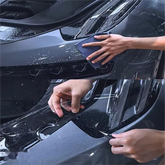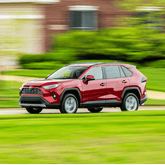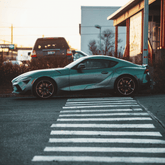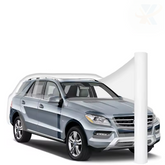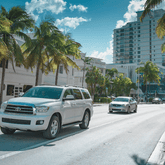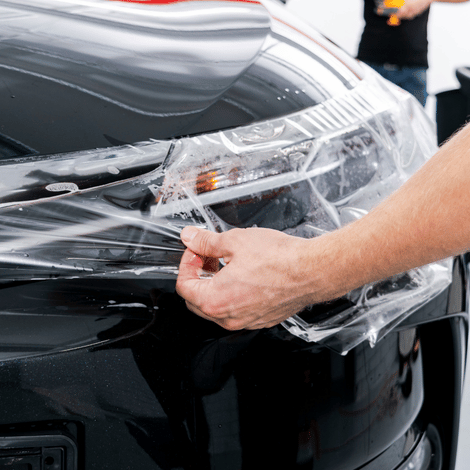A Comprehensive Guide to Paint Protection Film (PPF) Wrap: Everything You Need to Know
Regarding car care and aesthetics, paint protection film (PPF) has become one of the most important things for preserving the integrity and appearance of vehicle surfaces. This guide gives readers an overview of PPF – what it is made up of, how it can be applied on different surfaces, and why anyone should use this product. This article also debunks some common myths about PPFs so that people can make better decisions when choosing them for their cars or other vehicles. If you love cars and want them always to look good or if you have a car but would like it protected from elements such as rain, sun rays, etc., then knowing about paint protection films is very important for you.
What is Paint Protection Film (PPF)?

What is PPF, and how does it differ from a vinyl wrap?
Paint Protection Film (PPF) is a kind of durable polyurethane material that is used as a transparent shield for vehicle paint against scratches, chips and other contaminants which can be caused by UV rays or chemical stains found in the environment like road debris. Unlike conventional vinyl wraps that only change the look of the car by adding color or texture, PPFs are made with protection as their main aim. Although they may offer some degree of safeguarding properties, too, vinyl wraps do not match up to PPFs when it comes to impact resistance and self-healing abilities. PPFs have been known to absorb minor scrapes quite effectively; sometimes even healing themselves when subjected to heat after getting light scratched thereby retaining appearances while lengthening lives of vehicles.
What are the main benefits of using paint protection film?
The main advantage of using paint protection film (PPF) is that it guards against physical damage like scratches and chips, thus saving the car's appearance. PPF also offers protection from UV rays, which can lead to paint fading and oxidization with time. Another good thing about it is that when heated slightly after being scratched, PPF has self-repairing properties so as not to leave any unevenness on its surface. It should be noted that this material does not require much effort for cleaning and can repel dirt along with other contaminants hence making vehicle care more accessible than ever before possible. Ultimately, this means that by installing such films, we ensure long-term value retention by protecting paints from daily usage strains and environmental hazards.
How does PPF protect my car's paint surface?
The main protection of the paint surface of a vehicle is its advanced polyurethane composition. It creates a strong shield that takes in all hits from stones and other harmful objects on the road when applied. The film is a barrier against scratches and chips by spreading out energy produced by minor collisions. Besides, PPF can repair itself after being subjected to heat, whereby it gets back its smoothness over slight scratches, hence ensuring uninterrupted care. Additionally, it shields against ultraviolet radiation, thus stopping paint from fading away or rusting for years, thereby keeping intact external appearance parts such as bumpers, covers, etcetera in good condition always.
How to Choose the Best Paint Protection Film?

Types of PPF available in the market
- Automatic recovery PPF: Applies a film that can cure itself of scratches and small abrasions by heating.
- Non-shiny Paint Protection Films for cars with matte finish.
- Super shiny paint protection films that enhance the luster of the vehicle’s surface while protecting it from damage.
- Invisible Defense Line which keep your car looking new while protecting it from wear and tear.
- High-performance Anti-Chip PPF designed to protect against heavy impacts in extreme conditions or during racing events.
What are the features of the highest-quality PPF?
The greatest quality Paint Protection Film (PPF) is the one that combines a range of important characteristics to enhance its efficiency and longevity:
- Heavy-gauge Material: The best PPF uses thicker materials than regular ones, which provides better protection against impacts and reduces vulnerability to tearing or piercing.
- Self-healing Technology: State-of-the-art films are embedded with self-healing properties that enable them to recover from minor scratches and swirl marks on exposure to heat; this ensures they retain their aesthetic appeal for longer periods.
- UV Resistance: Quality PPFs are designed with formulations capable of resisting ultraviolet radiation while still maintaining their clarity over extended periods thus preventing yellowing or other forms of deterioration from occurring in the paintwork
- Hydrophobic Properties: High-end versions of PP film come equipped with a hydrophobic surface which repels water and dirt thereby making them easier to clean as well as maintain besides contributing towards increased life span of such coatings
- Chemical Resistance: Top-rated paint protectors offer excellent resistance against various chemicals such as bird droppings, tree saps, and road salts among others thereby safeguarding the vehicle’s finish against potential damages caused by these substances
- Warranty Coverage: Well-known manufacturers back up their top-notch products with extensive warranties that cover many years showing confidence in durability and performance levels achieved by premium PPFs over time
Comparison between PPF and wraps for your car.
Many factors are important if you want to differentiate between the use of Paint Protection Film (PPF) and vinyl wraps for vehicle customization and protection.
- Function and Safety: Essentially, PPF is used to protect the paint job on a car from scratches, chips, and other hazards that may come from the environment. On the other hand, vinyl wraps also provide minor protection while serving aesthetic purposes such as enabling full color change or unique designs unlike PPF which provides less protection.
- Longevity: Compared to wraps which can last up to five years with proper care because they are prone to fading and peeling off easily, PPFs have a longer life span ranging between seven years or more depending on how well they are maintained since it has self healing capabilities too so even when scratched it heals itself back within some time thus can stay looking new forever. In addition PPF lasts longer than wrap due its toughness against abrasions among other qualities like self-healing abilities etcetera .
- Installation and Costing: When it comes to installation, both types require professional expertise, although this may vary depending on individuals’ needs. Generally speaking, PPFS demand more refined skills due to advanced technologies employed alongside their protective nature, making them expensive compared with VWS; however, before settling down, one should take into account possible replacement expenses over a given period.
- Maintenance: Another area where these two differ greatly lies in maintenance requirements because of hydrophobicity property exhibited by most paints coated under this category i.e., easy cleaning capability enhanced by being water resistant; However some vinyls need regular attention especially where weather is harsh lest their outlook deteriorates completely over time.
At last people must choose either between protecting their cars or beautifying them according to their budgets.
Installation Process: What to Expect?

How is Paint Protection Film installed?
The installation of Paint Protection Film (PPF) is normally done in a series of steps to make sure it works well and lasts long.
- Preparation: The vehicle’s surface is cleaned using a clay bar and special cleaning solutions to get rid of any impurities, wax or polish that could prevent it from sticking.
- Template Creation or Sizing: Many experts use computer-aided design (CAD) software which allows them to create templates fitting exactly round the curves of the cars. Manual measurement and cutting might also be done during this step especially when it comes to custom applications.
- Application: The film is applied onto the surfaces of the vehicle being very careful about it so as not to damage anything. Wetting it with soap water solution helps in positioning while getting rid off bubbles.
- Squeegeeing: A technician pushes out all trapped air or water beneath where film has been laid by use a squeegee hence ensuring strong adhesion between PPF and car finish.
- Trimming and Finishing Touches: Once everything is properly adjusted, excess material can be trimmed away so that there are no visible edges left behind, which may adversely affect appearance. Heat guns are sometimes used to help PP films conform properly around tight/curved areas like mirrors’ backsides, among others; heat also makes them stick better in such places!
- Curing Time: It is always advisable that one should not touch or do anything on their recently PPF coated vehicles for at least 24-48 hours since this period allows adhesives used cure & bond more effectively thus securing protection provided by these products against paintwork damages caused due various reasons.
When carried out correctly by trained professionals, these stages provide an enduring protective coating over painted surfaces of automotive bodies.
Can I install PPF myself, or do I need an installer?
Although it’s technically feasible to do so, we strongly advise against self-installation of paint protection film (PPF). There are a few reasons for this. The first is that applying PPF is a precise process that requires skill in order to achieve the desired look; if done incorrectly, there will be air bubbles under the film, which misaligns everything and makes it look bad. Secondly, professionals use more advanced tools like templates or CAD programs which allow them to get an exact fit around complex vehicle shapes. Finally, experienced workers also know how long each part needs to cure before moving on to another one – this ensures maximum adhesion strength between layers and the overall longevity of the product. In conclusion, while you can do it yourself, professional installation would give you better results in terms of aesthetics and durability.
What should you look for in a professional PPF installer?
There are a few important things to consider when selecting a professional installer of Paint Protection Film (PPF). Primarily, assess the experience and training of the technician in applying PPF and their knowledge about various car brands and models. Also, read customer reviews or testimonials to get an idea of past performance quality. Furthermore, ensure that only high-quality materials made by well-known manufacturers are used by installers because it affects directly how long-lasting and efficient the film will be. It’s also good to ask for guarantees given both on workmanship done during installation as well as films themselves since it acts as an assurance towards quality. Ultimately, what sets apart good from great is detailed consultation where they listen carefully enough to understand what you want to be addressed before answering any queries and then outlining the steps involved clearly
Maintenance and Longevity of PPF Wrap

How long does a PPF wrap last?
Typically, a paint protection film wrap lasts between 5 and 10 years. The durability of this material depends on some factors, which include the type or quality of the film used, how well it was installed, and the level of care accorded to it. Higher quality PPFs are more resistant to wearing off, but they are also known for their hardiness against other forms of deterioration; moreover, professional installers ensure that they bond perfectly with painted surfaces, thereby guaranteeing maximum efficiency in performance while being adhesive. The life span may be increased through frequent maintenance like washing as well as avoiding the use of strong chemicals so as not only to keep its look but also preserve the ability to offer protection by the film.
What is the best way to maintain a PPF film?
To effectively sustain a Paint Protection Film (PPF), consider the subsequent precautions:
- Regular Cleaning: Routinely cleanse the automobile with car shampoo that is pH balanced and a soft microfiber wash mitt which will safely remove dirt contaminants without harming the film.
- Avoid Harsh Chemicals: Do not use strong cleaning agents, alkaline or acidic substances, or abrasive materials, as these can damage the surface of the film and reduce its protective capabilities.
- Dry Properly: After washing, the surface must be dried using a clean, soft microfiber towel to prevent water spots or streaks from appearing.
- Inspection: Periodically examine your paint protection film for bubbles and peeling, among other signs of damage, then take necessary actions such as contacting professionals who deal with such issues promptly.
- Avoid High Temperatures: Whenever possible park under shade or cover up cars when exposed to direct sunlight for long hours because high temperatures heat up causing them turn yellowish over time.
By observing this care guide, you will be able to keep your PPF wrap looking good while also protecting it.
Do PPF films self-heal from scratches and contaminants?
Absolutely, a lot of top-notch Paint Protection Films (PPF) can heal themselves. Such an ability enables them to vanish little scratches and swirl marks that come as a result of normal wear and tear when heated through exposure to light or warm water. The uppermost layer of the film is constructed in such a way that it melts down and levels off again thus giving it back its initial look while sustaining the best guarding features possible. However, let us bear in mind that deeper cuts or heavy scrapes may still need professional mending or replacement even if they self-heal. The capacity of these films for self-renewal can be improved by consistent servicing coupled with correct handling.
Common Issues and Solutions for PPF Users

How do we deal with air bubbles underneath the PPF?
To evade wrecking the film it is necessary to be careful while dealing with air bubbles beneath Paint Protection Film (PPF). Start by piercing the bubble using a pin that is sharp and clean so as to let the air out. Employ a soft cloth or squeegee to press gently on the bubble thereby pushing the film back into its place. In order for easy movement of the film, you can moisten it slightly especially if dealing with bigger bubbles; for example, soapy water can work well as a lubricant. Make sure that after releasing the air out of it, this area is dried completely to avoid trapping any moisture underneath which may result in complications later on. If this problem does not go away or if one lacks confidence doing such things themselves then seeking help from an expert installer would be recommended.
What to do if the PPF turns yellow?
A yellow tint on paint protection film (PPF) usually suggests that it may have been exposed to harmful environmental factors for a long time such as UV rays. Cleaning the film entirely with an automotive cleaner that is neutral in pH and a microfiber cloth for removing contaminants from its surface should be done first if this problem arises. If you still notice some yellowness, apply a dedicated PPF restorer or polish to regain clarity in certain areas. But when these steps fail to improve the situation significantly, then there might be deeper issues – like degradation of the material itself – which would require professional inspection and replacement if necessary. To prevent yellowing again later on, it’s recommended that one maintains their PPF regularly by gently cleaning it as well as shielding against excessive sunlight exposure.
Can PPF protect my car from bird droppings and other contaminants?
Indeed, Paint Protection Film (PPF) was made so as to safeguard cars against different environmental hazards such as bird droppings and other contaminants. It acts like a shield by absorbing the effects caused by these substances, thereby preventing scratches, etching, or discoloration on the original paint job of a vehicle. The protection provided will last longer if one cleans it frequently and removes all dirt particles that may have stuck onto it.
Frequently Asked Questions about Paint Protection Film (PPF)

How much does a PPF wrap cost?
The price range for a paint protection film (PPF) wrap is quite wide; it depends on which type of film you choose, how big your car is, and how complicated the job will be. Full vehicle wraps usually cost between $1,500 and $5k but partial ones can run from about $500 up to around $2k if they cover enough area. To ensure that this product works well and lasts long on your vehicle it is best to get quotes from different certified installers who can provide quality service – because installation matters most!
Can PPF be removed without damaging the vehicle’s paint?
Indeed, so long as it is done correctly PPF can be removed without damage to a car’s paint. Heat may be used by professionals to soften the adhesive and allow for slow, careful peeling when ensuring that the sticky backing does not stick on after applying the film. Still, how well this operation goes could depend on some things like how old or good quality the installed product is according to my knowledge; therefore it would be best if you got in touch with someone certified who can evaluate your case and take off the wrap in a safe way which preserves integrity of paintwork on vehicles.
Is there a warranty for PPF wraps?
Indeed, warranties are provided by most Paint Protection Film (PPF) manufacturers and usually last between 5 to 10 years. Commonly, such guarantees include yellowing, cracking, peeling, or excessive discoloration, among other problems, which ensure that it stays protected over a long time. Sometimes installers may give extra covers for their skillfulness in fitting the product onto your vehicle professionally. Nevertheless, it is important to read through warranties because they differ from brand to brand and one installer’s warranty may not be the same as another’s so do not expect them all to offer uniform protection levels against different damages caused by various factors like environmental contaminants etcetera while still being aware about what exactly each item covers under them can help consumers choose wisely among different PPFs available in stores or workshops around town depending on whether you want DIY or professional installation.
Reference Sources
Frequently Asked Questions (FAQs)

Q: What is paint protection film (PPF), and how does it work?
A: Paint Protection Film (PPF) is a thermoplastic urethane film applied to the surface of a car to protect the paint from minor abrasions, stone chips, and bug splatters. It’s also said that sometimes it can heal itself when having scratches, what it does is to repair them little by little with time. In order words, PPF works by creating an invisible shield on top of your vehicle’s finish that shields against debris, airborne or otherwise, and preserves both appearances as well as the originality of paints.
Q: How is paint protection film different from regular vinyl wraps?
A: Although they both serve to protect a car’s coat, PPFs are thicker and offer better physical damage resistance than most vinyl wraps, which lack the self-healing capability common in many PPFs. On the one hand, vinyl wrapping changes aesthetics more than anything else since there are myriad colors & finishes available, but this doesn’t mean that these films cannot guard against light impacts, too, like their counterpart mentioned above. You can combine them together.
Q: Can I remove PPF without ruining my car's factory paint job?
A: Yes! Quality matters so look for reputable brands such as Suntek or Xpel when buying your kit; these should come off easily without causing any harm whatsoever thanks largely to strong yet non-corrosive adhesives used during production stages which make removal safe even if done incorrectly on site. Still we recommend professionals do removal because you might end up damaging something unintended if not careful enough.
Q: Are there different types or finishes of paint protection film?
A: Ppf comes in various looks, including a glossy finish for those who prefer shiny surfaces, while others may want a matte appearance instead, so they have options here, too. If someone wants to change color altogether, then colored ppf would be a perfect fit for him/her but still offer the same level of defense against damages that may occur while driving around various places, which is why they’re made differently in terms of what each type does.
Q: How long will the paint protection film last on my vehicle?
A: A number of factors will influence the length of time PPF can stay on your car, like quality, among others, but most importantly, where you live plays a big role since some regions experience harsh conditions than others, thus affecting the duration before replacement becomes necessary. However, with good maintenance, even average-grade films such as those from Avery can hold up well for about five years, although they’ll need more care if one expects them to serve longer, so always keep clean and avoid using strong chemicals during washes, or else it’ll deteriorate quickly.
QCan I install Paint Protection Film by myself, or should I hire a professional?
A: To achieve a flawless finish, it’s recommended that PPF be applied by an experienced detailer although there are those who would try to do it themselves. This installation process requires skills and experience as well as proper tools like vinyl wrap tools and squeegees for correct fitting of ppf without any bubbles showing on the surface. Additionally, experts can ensure films are positioned accurately and stick well around complex areas such as bumpers.
Q: How does self-healing paint protection film work?
A: Self-healing PPF has a top coat that is capable of mending small scratches on its own. The polyurethane film's elasticity allows it to bounce back into shape when heated by sunlight or hot water, thereby healing minor scrapes and scuffs, too. This feature helps preserve the coating's appearance while maintaining its longevity.
Q: What do I need to do so that my paint protection film will last me longer?
A: Soft washing your car regularly with mild methods is part of taking care of your PPF. If possible, avoid using high-pressure washers near the edges of the film and use only car wash products that are safe for these types of coatings; this will help increase their lifespan. Furthermore, one should also inspect them once in a while, looking out for signs such as wearing off or tearing, and then take necessary actions, like seeing specialists at detailing centers.
Q: Does acid rain cause corrosion on cars protected by Paint Protection Film?
A: Yes, but only if left unprotected from environmental hazards like bird droppings containing acidic substances, which eat away metals, resulting in rusting, known as acid rain. Therefore, PPF acts as a shield against corrosive elements, thereby preserving structural integrity and the appearance of vehicles.
Q: Where can i get a quote on installing Paint Protection Film free?
A; Most automotive detailers offer complimentary estimates on PPF installations. Contact local businesses or check their web pages for more information on protective films and related services they offer.
